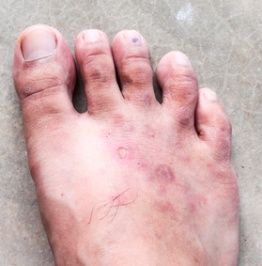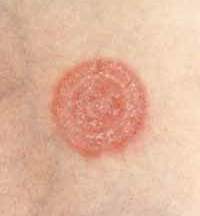
Can you get athlete’s foot on hands? Well, sort of. It sounds strange, though, doesn’t it? We’ll tell you how that might happen and what to do about it if it does. First, though, let’s talk a little about what an athlete’s foot is.
What is an Athlete’s Foot Infection?
The athlete’s foot is caused by a fungus. It is actually the same fungus that causes ringworm. The condition is just referred to as athlete’s foot when it occurs on the feet. It causes a circular red rash, which may be crusty or scaly. It is usually itchy and may even be painful.

It is easy to catch and is often picked up by walking barefoot on locker room floors, which is where the name “athlete’s foot” comes from. You can get it in other ways, though. Here is more on how an athlete’s foot is spread.
So How Can You Get Athlete’s Foot on Hands?
If athlete’s foot is a fungal infection of the feet, how could you get it on your hands? Well, you can get ringworm anywhere on your body, including your hands, and that’s the same fungal infection that causes athlete’s foot. The condition would not normally be referred to as athlete’s foot, though. It is generally just referred to as ringworm when it occurs on the hands.
Dermatophytid Reactions
Some people experience an allergic reaction to the fungus that causes athlete’s foot. For reasons that doctors don’t quite understand, a dermatophytid reaction is an allergic reaction that causes a red, bumpy rash on some other area of the body than the area affected by the fungal infection. For instance, an athlete’s foot might trigger a dermatophytid reaction on your hands. It is possible to experience a dermatophytid reaction on areas other than your hands and it is possible to experience it on several areas of the body at once.
The rash caused by a dermatophytid reaction is usually very itchy. The rash may resemble hives or even look like the area is bruised.
Preventing Fungal Infections Such as Athlete’s Foot on Hands
The following steps may help prevent athlete’s foot and other fungal infections on your hands.
- Keep your hands clean and dry.
- Don’t share personal items like towels and bed linens with other people.
- Pets (including cats, dogs, rabbits, ferrets, and other domestic animals) can get ringworm, the fungal infection that causes athlete’s foot, and you can catch it from them. If your pet has a rash or is losing hair, make an appointment with your vet. If you think your pet may have a fungal infection, avoid touching the animal as much as possible until the infection has been treated and wash your hands after any handling.
- The athlete’s foot can spread from the feet to other areas of the body, including the hands. To help prevent spreading, treat any fungal infection right away.
Note that these steps won’t prevent a dermatophytid reaction from occurring on your hands in response to an athlete’s foot.
Treating Athlete’s Foot on Hands
Fungal infections on the hands can usually be treated with over-the-counter medications. See your doctor if your condition doesn’t improve with over-the-counter medications. In rare cases, people need prescription ointments or antifungal pills.
Antifungal medication applied to the hands won’t help if what you’re experiencing on your hands is a dermatophytid reaction. Antihistamines, available over the counter or by prescription, might help. The Merck Manual(1) suggests that corticosteroid creams, available over the counter or by prescription, may relieve itching. Your doctor might also prescribe steroids if you are having a significant dermatophytid reaction. We recommend talking to your doctor about the best treatment for you. In addition, treating the fungal infection on your feet should help the dermatophytid reaction on your hands, since that type of reaction is a direct result of a fungal infection elsewhere on your body.
Our Preferred Remedy for an Athlete’s Foot Infection
For treating ringworm on the hands, we recommend Phytozine. It contains Tolnaftate, which is an FDA-approved medication for treating ringworm infections. The manufacturer guarantees it to work.
Our preferred remedy for athlete’s foot is called H-Athlete’s Foot Formula. It’s an all-natural formula consisting of homeopathic ingredients and essential oils that kill the fungus that causes athlete’s foot while also relieving the itching and discomfort caused by the condition. It won’t help with a dermatophytid reaction, though, so see your doctor if you need treatment for that. To find out more about H-Athlete’s Foot Formula and why it’s our preferred remedy for athlete’s foot, just follow the links.
(1) Merck Manual
